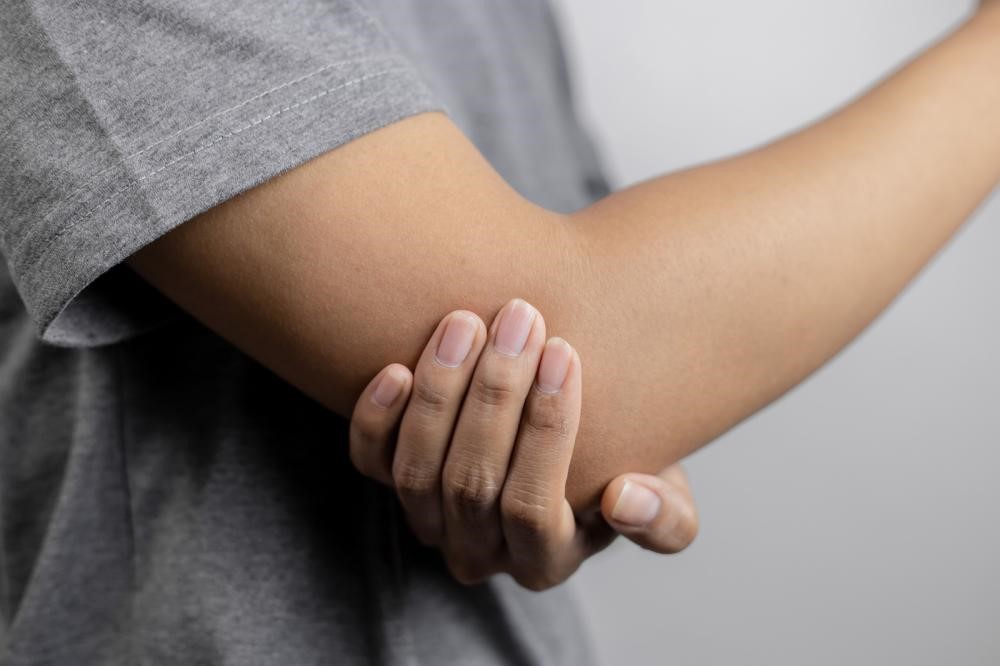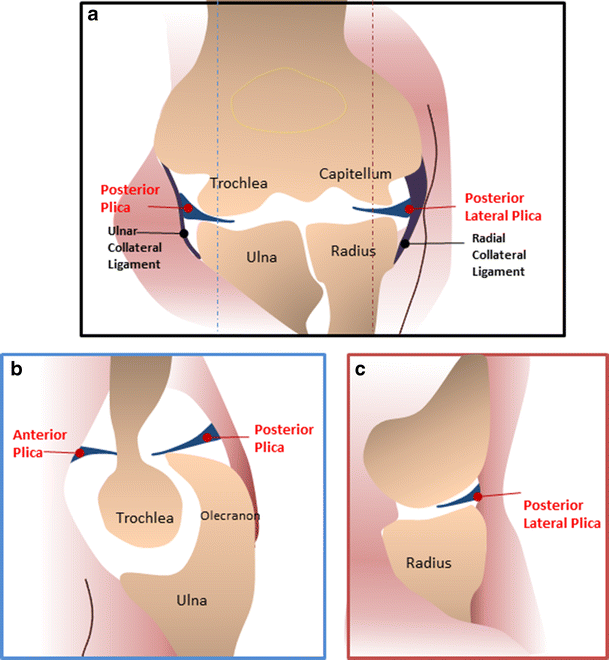nalco group
bone, muscle & joint pain physio
BOOK NOW / WHATSAPP ABOUT YOUR PAIN OR INJURY
- NOVENA 10 Sinaran Drive, Novena Medical Center #10-09, Singapore 307506
- TAMPINES 9 Tampines Grande #01-20 Singapore 528735
- SERANGOON 265 Serangoon Central Drive #04-269 Singapore 550265
Home > Blog > Physiotherapy & Hand Therapy > Conditions > Shoulder Pain / Elbow Pain > Synovial Plica Elbow Pain Physiotherapy
Synovial Plica Elbow Pain Physiotherapy

What Is Elbow Synovial Plica?
Synovial plica basically refers to the inflammation of a small part of soft tissues in the elbow joint. To fully understand what plica syndrome is, you must be familiar with the basic anatomy of the elbow.
The synovial membrane, called synovium, is a layer of connective tissues that line the inside of the joint capsule. It produces synovial fluid that serves to lubricate the joint and reduce friction between bones during movement.
This tissue starts folding inward during fetal growth but is usually resorbed, leaving a small empty area in the elbow cavity. However, many a time, the tissue resorption occurs only partially. This means that in many individuals, the normal cavitation of the elbow remains incomplete.
In other words, they have ‘plicae’ by birth.
Given the natural elasticity of the synovial membrane, the plicae usually do not hinder the normal joint function.
However, certain factors, such as hitting your elbow on a hard surface or extensive use of the joint for repetitive movements, can cause them to become irritated and inflamed. When this happens, the joint becomes painful, and the movement of the arm can get restricted. This disorder is called synovial plica syndrome.
According to medical research, synovial plicae are present in more than 80% of the general adult population. However, symptomatic synovial folds are much less common and account for less than 8% of all elbow arthroscopies.
Diagnosing synovial plica can be quite hard as its symptoms can be linked to a range of common elbow conditions.
But once a plica is identified as the source of joint pain, you can recover from it effectively and efficiently.

Elbow synovial plica is a rare condition of the upper extremity that is often confused with Tennis Elbow (another painful elbow condition).
It is typically characterized by:
- Sharp or shooting pain in the elbow
- Instability of the elbow joint
- Catching or locking sensation of the elbow
Other names given to elbow synovial plica include:
- Elbow synovial fold syndrome
- Snapping elbow syndrome
- Skipping elbow syndrome
Synovial plica usually occurs in athletes and people who frequently engage in activities involving repetitive motion (e.g., hammering, typing, etc.).
It can also develop due to a direct hit injury or blow to the elbow.
In this article, we take a detailed look at what elbow synovial plica is. We discuss its symptoms, causes, risk factors, and how it can be treated with appropriate elbow hand therapy or physiotherapy.
What Causes Synovial Plica of the Elbow?
The most common cause of synovial plica syndrome is direct trauma to the elbow joint.
For example, if you fall onto your elbow or sustain a hit on the joint during a car accident or a sports incident, it is likely to inflame your synovial folds. However, there are several other factors that can also result in inflammation of the elbow’s synovial membrane.
These include:
- Reduced mobility of the elbow joint (due to old age, sedentary lifestyle, etc.)
- Stiffness of the arm muscles
- Muscular weakness that places abnormal stress on the joint capsule
- Natural deformities in the arm or elbow structure
- History of elbow fracture or joint dislocation
- Any medical condition, such as arthritis or osteoporosis that affects joint health
- Improper biomechanics, i.e., incorrect use of the arm or elbow, especially during sport activities
- Prolonged use of elbow for activities involving a repetitive motion
- Over-training at the gym
Symptoms of the Elbow Synovial Fold Syndrome
People with elbow synovial fold syndrome are likely to experience:
- Dull persistent pain in the arm that intensifies after elbow use
- A sharp, stabbing, or shooting ache when you move the elbow in a certain position
- Sensitivity to touch in the inner or outer side of the elbow
- Localized swelling in the elbow
- Reduced elbow range of motion / movement
- Increased elbow joint laxity – a feeling that your elbow is going to ‘give out’ if you try to bend it at a particular angle
- A snapping or catching/ locking sensation when flexing or straightening your arm
- Tightness in the elbow
- A clicking or ‘popping’ sound when you bend or extend the elbow joint
Who Is At Risk of Developing Elbow Synovial Plica?
- Athletes are always at risk of developing synovial fold syndrome
- Older adults also have an increased chance of developing synovial plica due to age-related joint degeneration.
- Individuals who perform hard manual labor every day are prone to suffering from snapping elbow syndrome.
- People with one or more of the following medical conditions are at risk of developing the plica syndrome which includes: Loose bodies from arthritis, Osteochondritis Dissecans, Lateral epicondylitis and Osteoporosis
- Individuals who frequently participate in throwing sports (e.g., basketball, volleyball, rugby) are susceptible to elbow pain due to irritated synovial plica.
- People who previously have had elbow surgery are also at risk of experiencing synovial plica pain as the surgical treatments can leave behind scar tissue.
Conditions Similar to Elbow Synovial Plica (differential diagnosis)
Elbow synovial plica is most commonly confused with:
Treatment for Synovial Plica of the Elbow
If you have elbow pain that does not go away, it’s essential to consult a medical provider at your earliest. A doctor or physical therapist can perform a thorough examination of your condition and determine the best treatment possible.
Our senior hand therapists and physiotherapists will take your health history and review your daily physical activities as part of the initial evaluation. The main aim of the initial assessment is to determine the extent of the injury and identify the factors contributing to your pain.
You will be asked to perform some specific movements with your arm under the supervision of the medical staff. This helps your physical therapist determine the strength and flexibility of your upper extremity, which includes your arm, elbow, forearm, hand, wrist, and fingers. In many cases, the swollen folds of the irritated synovial lining in the elbow joint capsule can be felt with touch (medical palpation).
However, at times, it might be necessary to capture radiographs for acute diagnosis. Your physiotherapist might prescribe you to get an x-ray or an MRI scan to help rule out other possibilities and identify the severity of tissue inflammation.
If required, we may consult an orthopedic surgeon for further assistance in providing you with a definitive diagnosis.
Once the presence and irritation of the plica is confirmed as the source of your elbow pain, we will work with you to control the tissue inflammation and help you return to normal activities.
How phoenix rehab hand therapists and Physiotherapists Can Help People with Elbow Synovial Plica
In order to eliminate the symptoms of synovial plica and help you regain the lost joint mobility and strength, we will use a range of treatment techniques in one or more of the following categories:
Pain Management
Pain management is typically the first step in the treatment of the synovial plica of the elbow.
This involves conventional pain-relief techniques, such as applying hot or cold compresses to the affected joint. We may customize an elbow thermoplastic splint to rest your elbow and relieve the strain on the joint.
We may also use electrotherapy or ultrasound therapy for optimal pain control so you can avoid medicines that often include steroids and opioids.

Many people with synovial fold syndrome benefit from manual therapy, which is applying hands-on pressure to gently move your elbow and arm muscles. This can include a sports massage to increase joint mobilization. Or it can be a deep tissue release or trigger point session that aims to soothe inflammation and, thus, reduce pain.
Range of Motion Exercises
After your elbow injury or the onset of synovial inflammation, you might find it challenging to move your arm freely. We will suggest and help you perform a set of different exercises that can help improve mobility and normalize the joint function over time.
Our senior hand and elbow therapists will work with you in a one-to-one setting and monitor you closely in order to prevent re-injury while exercising.
Strengthening Exercises
Poor muscle strength can aggravate the symptoms of the synovial fold syndrome and hinder fast recovery as well. Our senior hand therapists and physiotherapist will help you build muscle strength through specific strengthening exercises customized to your exact goals.
They will take into account a range of factors, such as your
- age
- medical history and
- current physical health
to choose exercises that best meet your needs.
Functional Training and Education
Once you get rid of the pain and significantly improve your elbow performance, we will move on to functional training. Functional training focuses on helping patients perform more physically demanding activities without irritating their synovial lining.
The aim is to help you correct your movements and use proper arm and elbow positions when engaging in sports. This allows you to gradually return to your favorite activities while helping you lower the risk of re-injury.
Synovial plica of the elbow can be effectively treated with physical therapy and our senior hand therapists and physiotherapists treat these cases commonly.
However, if the inflammation is too severe or response to initial treatment is refractory, surgery might be required eventually. It is a minimally invasive procedure, but you will have to follow up with physical therapy to ensure proper healing and avoid post-surgery complications.
